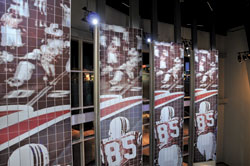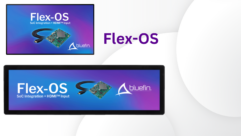

Vital Signs: Trends in Digital Signage
Digital signage has become a must-have AV application. Today, added-value technologies, such as interactive software and wireless networking, are breathing fresh life into new digital signage projects.
As price points for LCD and plasma display technologies have come down in the last several years, digital signage has grown in prominence. Still, the channel remains young, its borders not entirely defined, and its potential vast.
With a broad swath of industries–retail, banking, health care, out-of-home advertising, you name it–just beginning to embrace digital signage, vendors, solution providers, and others have flooded the market with convergent technologies that encompass both IT and AV disciplines.
“There are more than 300 digital signage companies in North America alone right now, most of them pretty small,” says Ryan Cahoy, vice president of Toronto-based digital signage software maker Rise Vision. “Everyone has started to smell the money. We’re still in an emerging market where all these standards are being developed, and we’re just trying to come up with common terminology. Everybody is trying to differentiate themselves.”
While IT companies like Cisco have embraced the market with gusto, pro AV integrators have yet to completely commit to it, says Vince Faville, digital signage market development manager for West Chester, Pa.-based Advanced AV. He says his outfit is one of only about a half dozen AV integrators in the U.S. that are aggressively competing in the market.
“A lot of AV dealers out there sell digital signage in their bag of tricks, but they’re not dedicated to it,” says Faville. Advanced AV is one of the few companies that has a dedicated digital signage division. “We never run into competitors in the AV world. In fact, when we do, we help each other, because [our regions] don’t overlap.”
For their part, Advanced AV officials have labeled digital signage a “killer app,” a market with unknowable growth potential at this point. But to properly exploit it, they say–and to keep IT integrators from completely dominating it down the road–AV pros have to dedicate more resources to it and become versed in the necessary skill sets.
“You can’t just sell off a line card,” says Faville, whose company has invested $100,000 to date to create a series of dedicated digital signage demonstration systems that potential clients can peruse at the company’s headquarters.
Moreover, to stand out in a fledgling market full of emerging competition, AV dealers and integrators must be versed in the latest technology trends and business models–everything from wireless networking to interactive features to vendor-supplied content. Digital signage is ripe for creative new approaches to a similar end result. The integrator who can tailor a solution using all the technology at his disposal, stands to win new business in a variety of markets.
“If you don’t, the IT guys will,” Faville says.
The following are some of the diverse ways integrators and their customers are deploying signage today.
Signage That Dazzles When the Sun Shines In
What> Reflective Display
Where> Patriot Place, Foxborough, Mass.
Hall at Patriot Place
The New England Patriots didn’t make the NFL playoffs this past season, so fans will have to take solace in the new Hall at Patriot Place, a 36,000-square-foot homage to the team and permanent home to its Hall of Fame that opened last September.
The Hall is also a multimedia wonder, with advanced AV systems that include 19 high-definition touchscreen kiosks, 11 60-inch HDTV monitors, seven projection screens, and a 48-foot-wide panoramic movie screen. And it’s home to the first indoor application of a unique, reflective signage technology from a company called Magink.
With offices in Israel and the United Kingdom, Magink makes what it has dubbed “digital ink” displays, composed of cholesteric liquid crystal technology. Because it’s reflective, the technology is said to be ideal for outdoor digital signage.
Indoors, where lighting conditions can vary or a venue might not want display light to overpower a space, the Magink reflective technology gives the impression of video wallpaper.
“The Hall at Patriot Place is the ideal venue for our first indoor installation,” says Ronen Zexer, CEO of Magink. “Our technology made it possible to show videos and still images on a large area display while not overpowering the indoor environment of the museum.”
A Magink display uses three layers of liquid crystal (red, green, blue) between sheets of glass–there is no heavy, embedded light source. Similar to some LED displays, Magink signage is made up of tiles (6.7x 6.7 inches; 18×18, 9mm pixels) that come in 3×3 modules. Video refreshes at 25 frames per second over DVI on a Magink display, while images refresh every approximately 250 milliseconds, making for stable, responsive signage.
Moreover, Magink’s technology reportedly uses less energy than LED, which was a significant requirement for the Kraft Group, which owns the New England Patriots and the Hall. By Magink’s own estimates, its technology would consume one-fifth the energy of a comparable 9-square-foot LED display. And because it doesn’t actually emit light, it doesn’t give off as much heat as other display technologies.
Magink worked with architectural design firm Cambridge Seven Associates and AV integrator Electrosonic to introduce the reflective display. At the entrance to the Hall at Patriot Place, there are several 30-foot-high Magink pylons showing still images and video of Patriot Hall of Famers. The signage is such that fans both inside and outside the Hall can see clearly what’s playing at all times.
The Magink display content can be triggered via touchscreen kiosks installed by Electrosonic. In fact, Electrosonic built interactive kiosks throughout the Hall. Video is served to a variety of locations from three Electrosonic MS9200P HD SDI MPEG-2 digital players; seven Electrosonic MS9500 HD MPEG-2 players; and 10 Electrosonic MS9500GL HD MPEG-2 players with genlock. Interactive content, which blends with the video, comes off Dell media servers.
“[We] customized the technical systems to meet the creative needs of Cortina Productions, which produced and encoded all the interactive and projected-video content,” says Electrosonic project manager Gary Barnes. “The results were incredible.”
According to Electrosonic, the Hall uses its ESCAN software as the venue’s master show control system. The ESCAN system talks to three Crestron CP2E systems with Ethernet capabilities for managing all projectors (including a slew of Christie Roadster DLP models), interactive kiosks, and every exhibit throughout the Hall.
And Electrosonic made sure the sound for all the interactive kiosks matched the visual experience. Each is equipped with local Innovox custom speakers.
When a Regular IT Backbone Won’t Do
What> Wireless Signage
Where> Staples Center, Los Angeles
Staples Center
Equipped with old-fashioned roller-ads, the dasher boards lining the home ice rink for the NHL’s Los Angeles Kings were perfect candidates for a digital signage upgrade last year. Simply put, digital signage would allow the team to service more advertisers in a more interesting and engaging way.
Late last year, the team agreed to a pilot program that replaced a few of their roller ads with digital signage.
For wireless infrastructure manufacturer* Internet Connectivity Group of Lake Forest, Calif., creating a networked digital signage solution in the Kings’ arena, the Staples Center, presented some key challenges, namely the expense and IT politics associated with adding a new network infrastructure to a 10-year-old building.
“Like a lot of legacy facilities, getting new wiring approved isn’t just cost-prohibitive, it requires significant network approvals,” says Will Geoghegan, director of marketing for ICG. “Getting the kind of committee you need to approve digital signage is difficult.”
The solution was to install a system that required no wires at all.
Technology-wise, the wireless transmission of video signals within digital signage applications still has a way to go. The Kings’ dasher boards, however, required mostly the display of static images–advertiser logos, mainly–with a limited amount of animated Flash effects thrown in for good measure. Such signage was imminently attainable with current wireless technology.
The heart of the Kings’ trial program is ICG’s proprietary digital signage module, a portable unit that fits neatly into an arena breaker box that’s 120 feet away from the digital sign mounted in the dasher boards.
The solution provider refers to this Windows-based module, which sells for $2,500, as its MobileMedia System. It is essentially a network appliance, designed to create its own Wi-Fi hot spot. It includes a PC, an 802.11 transmitter, and a 3G/4G wireless network module.
While ICG’s MobileMedia System is designed to support full-motion, 1080i HD content, the initial install at the Staples Center only required transmitting still images. Compressed and encoded graphics files–usually ranging from 200 to 300 kilobytes in size–are sent from ICG’s MobileMedia System directly to a 802.11 receiver called the ViFi adapter mounted within the dasher boards behind the display units.
The display units themselves include three tiled 40-inch LCD displays, mounted in a 3×1 alignment in a shock-rated chassis that’s fully integrated within the internal frame of the dasher board.
Once received, the files are decoded by the ViFi adapter*. These simple graphics files arrive with a limited amount of coded instruction, which tells the player how to locally render the displayed image with effects files that have already been uploaded. For example, an ad for a beer company might move from left to right across the tiled display surface, as the logo of a bank moves over to take its place.
“You don’t want to transfer huge files on a wireless network,” Geoghegan says. “Instead of trying to send very large media files through the network, the software allows us to take very simplified images, create the effects we want without rendering them, then have those effects rendered at the local level.”
Kings staff, meanwhile, has the luxury of controlling the system and adding content from virtually anywhere. The MobileMedia box connects to the Internet via a 3G network, the same as, for example, an iPhone. Using just such a mobile device, staffers can connect with the system via a Web-based interface, changing and uploading ads at their pleasure.
The entire integration occurred without having to involve anyone from Staples Center’s IT staff. ICG is still waiting to hear back as to whether the Kings want to replace all the roller ads that surround their home ice with these next-generation signs, but Geoghegan is confident the client likes the results so far.
“It’s a very clean, simple architecture and execution,” he says.
* Editor’s note This page has been modified to reflect ICG’s business as a solution provider not an integrator, and to specify that the ViFi adapter is the component that handles decoding in the dasher boards.
Vital Signs: Trends in Digital Signage
Digital signage has become a must-have AV application. Today, added-value technologies, such as interactive software and wireless networking, are breathing fresh life into new digital signage projects.
Adding Context to Content
What> Interactivity
Where> Bell Canada Retail Stores
When visitors to the more than 125 Bell Canada retail outlets across Ontario pick up a wireless telephone to inspect for possible purchase, a magnetic link on a sensor is broken and a signal is sent through the USB port of a nearby Windows-based PC. Omnivex digital signage software system loaded onto that machine registers the event and which product the consumer picked up.
The digital signage system, in turn, interfaces directly over Bell Canada’s network with the company’s point-of-service database to instantly download pricing, specs, calling plans, and other relevant information for that specific product. A message then appears almost instantly on a 15-inch, Elo touch screen LCD monitor that sits adjacent to the customer, inviting him or her to learn more about the specific phone model he or she is looking at.
At this point, the Omnivex digital signage system acts as salesperson, offering the customer a range of data via the touchscreen interface.
“Bell Canada already knows from its POS system what its customers are buying, but what they don’t know is what people look at before they buy and how they’re making their comparisons,” says Omnivex president Jeff Collard. “The software gives them the ability to do that.”
Not only are customers better able to make side-by-side comparisons in stores, the data on what they’re looking at is collected and compiled on Bell Canada’s network and is viewable in real time from headquarters.
According to Collard, Omnivex, which already partners with Bell Canada on the telecommunications company’s own digital signage enterprise, is currently in the process of rolling the system out to all 600 Bell Canada outlets across the Great White North.
Omnivex is itself handling some of the systems integration, configurations of which vary greatly, depending on the size and location of specific outlets. Montreal-based IT integrator CGI, meanwhile, has been contracted by Bell Canada to oversee some of the installation as well.
“Everybody always says content is king but that’s not really true,” adds Omnivex CEO Doug Banister. “Context is king. Content must be relevant to the person looking at it.”
The Content Conundrum
What> Software as a Service
Where> The Julliard School, New York
The Julliard School
With many of them prone to receiving a steady flow of their own live data through mobile devices and social networks, students at colleges and universities aren’t the easiest audience to reach over a digital signage network programmed with campus news and event information.
“The first time you show it, they’ll look at your message,” says Ryan Cahoy, vice president of Toronto-based digital signage company Rise Vision. “By the third time the system has refreshed and you’re showing the same thing, their spam filters are up.”
Previously, facilities like the New York-based fine-arts mecca The Julliard School might have been turned off by integrating a digital signage network, not only because of the setup costs, but also because of the expense and hassle of maintaining and programming it.
“Given the state of the economy, everybody is trying to cut cost and simplify what they have to manage themselves,” Cahoy notes. “You don’t have to have a dedicated IT guy manage our software. It’s just a predictable subscription.”
For its part, Rise Vision recast its business model several years ago to be a Software-as-a-Service (SaaS) provider, getting in early on the now-ubiquitous trend in the digital signage industry toward vendor-managed content. In fact, even AV integrators in the space increasingly now provide content services.
“For Julliard, one of their challenges was that the original AV consultant they used recommended a software product that was too complex and expensive for their day-to-day needs,” Cahoy explains. “After trying to learn the other system, they shifted their focus to finding an easy-to-use system that could provide attractive content.
Paying Rise Vision a $1,200 consulting fee for systems design, campus IT administrators self-installed two 57-inch Samsung 570Dx LCD displays, mounting one right on top of the other in the lobby area of the school’s main campus at the Lincoln Center for the Performing Arts. Both are powered by a single Now Micro AOpen DE 965 media player, equipped with two VGA outputs that let it program and control both displays as one large unit via standard RGBHV cables.
The media player, in turn, blends its digital signage content from two networked sources. The first is the Rise Display Network, a subscription, Web-based service (Julliard pays $800 a year) that includes wire-service-fed news, weather, entertainment, and sports information–24/7 eye candy, if you will, to keep people engaged with the signage.
Campus administrators, meanwhile, have their own password-protected, Web-based interface running on their own network for inputting local information and announcements. This content is blended on the media player with Rise Vision’s 24-hour news feed and presented on the displays in custom-designed templates.
“An added bonus to the system was the ability to send emergency alerts from a Web browser or from a mobile browser on a cell phone in the event of a crisis,” Cahoy notes.
Vital Signs: Trends in Digital Signage
Digital signage has become a must-have AV application. Today, added-value technologies, such as interactive software and wireless networking, are breathing fresh life into new digital signage projects.
That Little Extra Pop
What> Projected Signage
Where> Swiss Farms Grocery Stores, Broomall, Pa.
No, it’s not a Swiss Farms installation, but when Advanced AV is finished with the digital signage project for the Broomall, Pa.-based grocery stores, it will include 3M’s Vikuiti rear-projection film screen technology, seen here. The Vikuiti technology makes for an interesting visual effect that can be seen in light and dark conditions.
Now garnering about 10 percent of its overall revenue from the digital signage market, West Chester, Pa.-based Advanced AV prides itself on execution of tried-and-true technology.
“We don’t do a lot of the fancy stuff,” says Vince Faville of the AV integrator. The company recently signed a deal with Broomall, Pa.-based Swiss Farms to outfit 13 of the company’s drive-through grocery stores with new signage systems.
At completion, each Swiss Farms outlet will have a bank of four 46-inch NEC 20 Series monitors, mounted in a 4×1 alignment, flanking both sides of the store.
When visitors drive up to the building, a sonic sensor will trigger the signage’s welcome sign to give way to a list of inventory, prices, and specials. Each four-display sign will be driven by a PC loaded with CoolSign digital signage software and networked with Swiss Farms headquarters in Broomall, where control of the signage is handled.
The digital system will have huge benefits for the convenience-based retail operation. From headquarters, administrators can establish a uniform look and feel for the signage. They can also make adjustments based on pricing and inventory fluctuations for staple goods like milk, coffee, and bread without having to rely on input from the largely teenaged staff working in the stores.
And while this kind of system doesn’t necessarily rise to the level of “fancy stuff” in today’s digital signage market, Faville says the company and its client are adding an extra element to the overall system in order to give the signage that extra visual pop.
Each store, he says, will have 3M Vikuiti rear-projection film screen installed in one of its main windows with a 3,500 ANSI lumen NEC LCD projector displaying advertisements onto the screen surface when the store is closed at night.
The eerie effect created by the Vikuiti film, which is sticky on one side and can be cut into almost any shape, will provide a unique visual presence that draws attention in a way that conventional digital signage cannot.
“We’re not sure what shape we’re going to cut this film into and how exactly we’re going to set the projection system up, but when we’re done, it’s going to draw attention and create brand awareness,” Faville says.
He adds that when negotiating with Swiss Farms officials for the project, this added visual pop gave Advanced AV a decided technological edge in terms of acquiring the business. “They almost jumped out of their seats when we explained to them what it is and how it works.”
Daniel Frankel is a reporter for Variety and a freelance AV writer. He’s based in Los Angeles. Pro AV editor Brad Grimes contributed to this article.










